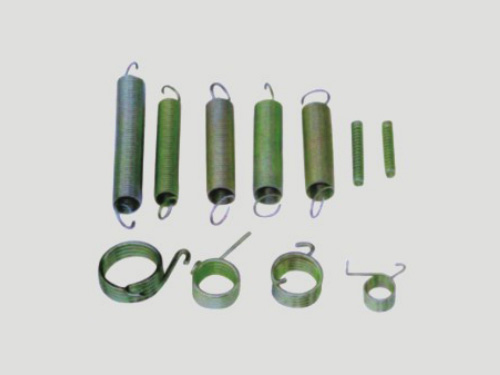Air valve mechanism
Air volume control valve actua
Air valve actuator
Remote controller for smoke ex
Air conditioning accessories
tuyere

Tension spring
Extension springs, also known as tension springs or simply extension springs, are helical springs that bear axial tension. The following is a detailed analysis of extension springs:
1. Basic definition and characteristics
Definition: Extension springs are mechanical parts that work by using elasticity, and they work by bearing axial tension.
Features: When the extension spring is not under load, the coils are generally tight and there is no gap between them. This characteristic enables the extension spring to generate a large rebound force when subjected to tension.
2. Materials and applications
Material: The materials of extension springs mainly include carbon steel wire, stainless steel spring wire, oil quenched and tempered alloy spring wire, high and low temperature alloy spring wire, etc. These materials have excellent elasticity and fatigue resistance, and can meet the needs of different working environments.
Application: The application fields of extension springs are very wide, covering defense, ocean, computer, electronics, automobile, mold, medicine, biochemistry, aerospace, railway, nuclear power, wind power, thermal power, engineering machinery, mining machinery, construction machinery, elevators and other fields. They play an important role in controlling the movement of mechanical parts, storing energy, and measuring the size of force in these fields.
3. Classification and specifications
Classification: According to the different load-bearing capacity and usage scenarios, tension springs can be divided into ultra-light load, light load, medium-light load, medium load, medium-heavy load, heavy load and extended heavy load.
Specifications: The specifications of tension springs usually include parameters such as diameter, length, wire diameter, number of coils, etc. These parameters determine the load-bearing capacity and working characteristics of the tension spring.
4. Working principle
The working principle of the tension spring is opposite to that of the compression spring. When the tension spring is subjected to axial tension, the distance between its coils will increase, thereby generating a reverse rebound force. This rebound force is the basis for the operation of the tension spring.
5. Precautions
When using tension springs, you need to pay attention to their load-bearing capacity and working environment. Avoid exceeding the load-bearing capacity of the tension spring or placing it in a harsh working environment to avoid affecting its service life and performance.
When installing and removing the tension spring, you need to follow the correct operating methods and steps to avoid damaging the tension spring or affecting its working effect.
In summary, as an important mechanical part, the tension spring plays an irreplaceable role in various fields. With the continuous advancement of science and technology and the continuous expansion of application areas, the product diversity and technicality of extension springs will continue to improve.
Working principle of the actuator of the air volume control valve
Electric air volume control valve, as an intelligent air duct equipment, is widely used in air conditioning systems in fields such as construction, medical care, and industry. It can automatically adjust the opening of the valve according to the air flow
2024-05-06
The execution content of the fire damper actuator
To drive the valve action, a matching actuator is required. The actuator used for fire dampers may not be electrically driven, but may also be electrically driven.
2024-05-06
The structural composition of the fire damper actuator
The fire damper actuator is a type of actuator used for fire dampers in ventilation and air conditioning system pipelines, which solves the problem of inaccurate adjustment of the opening angle of valve blades, thus unable to accurately control the ventil
2024-05-06
What functions can the actuator of the air volume control valve achieve?
The actuator of the air flow regulating valve is an automated equipment used to control the air flow valve in ventilation ducts. It can automatically adjust the opening of the air valve by receiving signals from the control system to achieve the goal of c
2024-05-06
